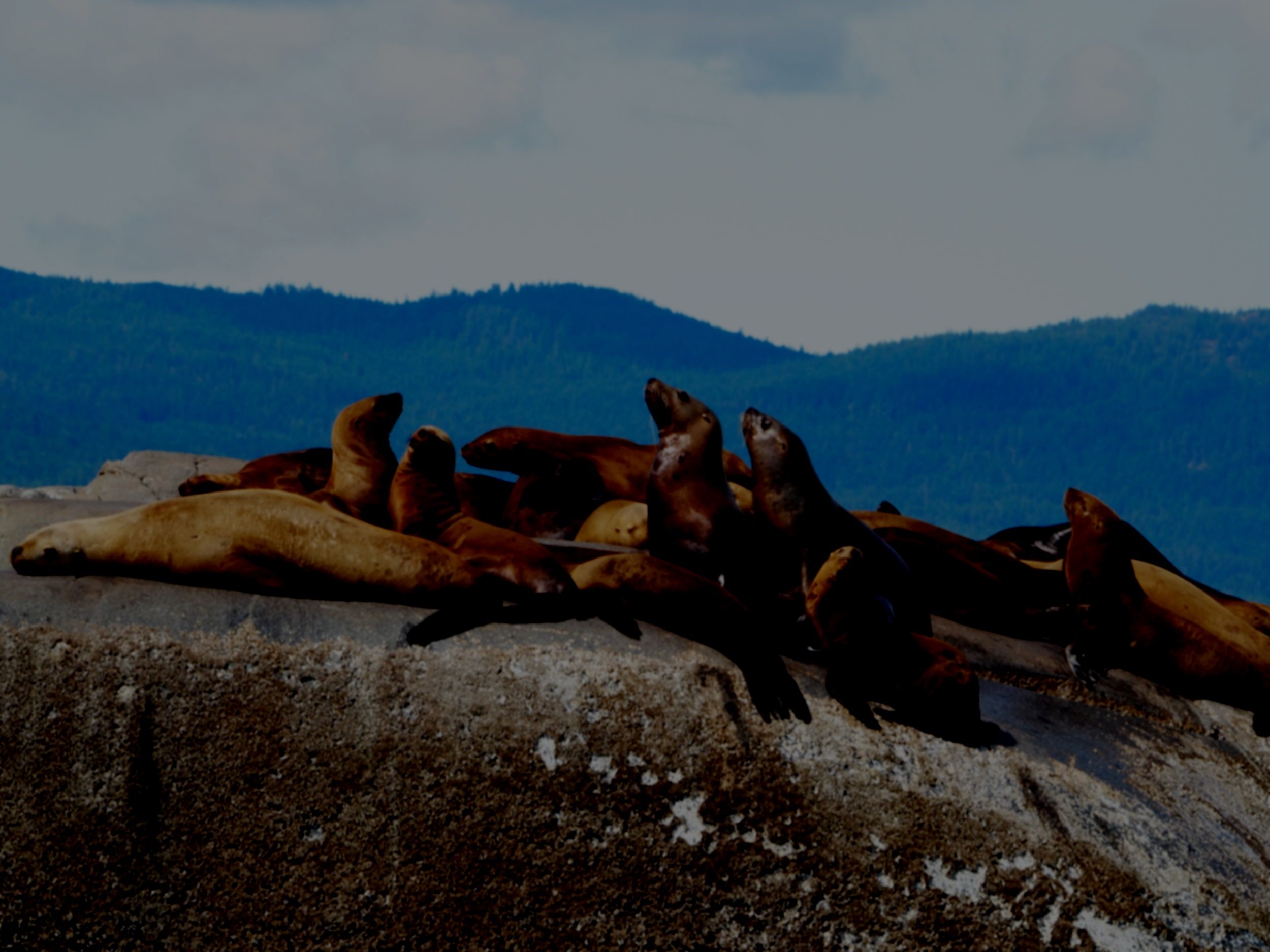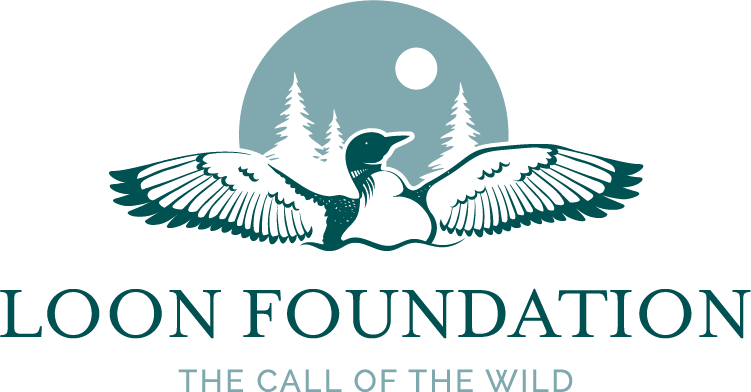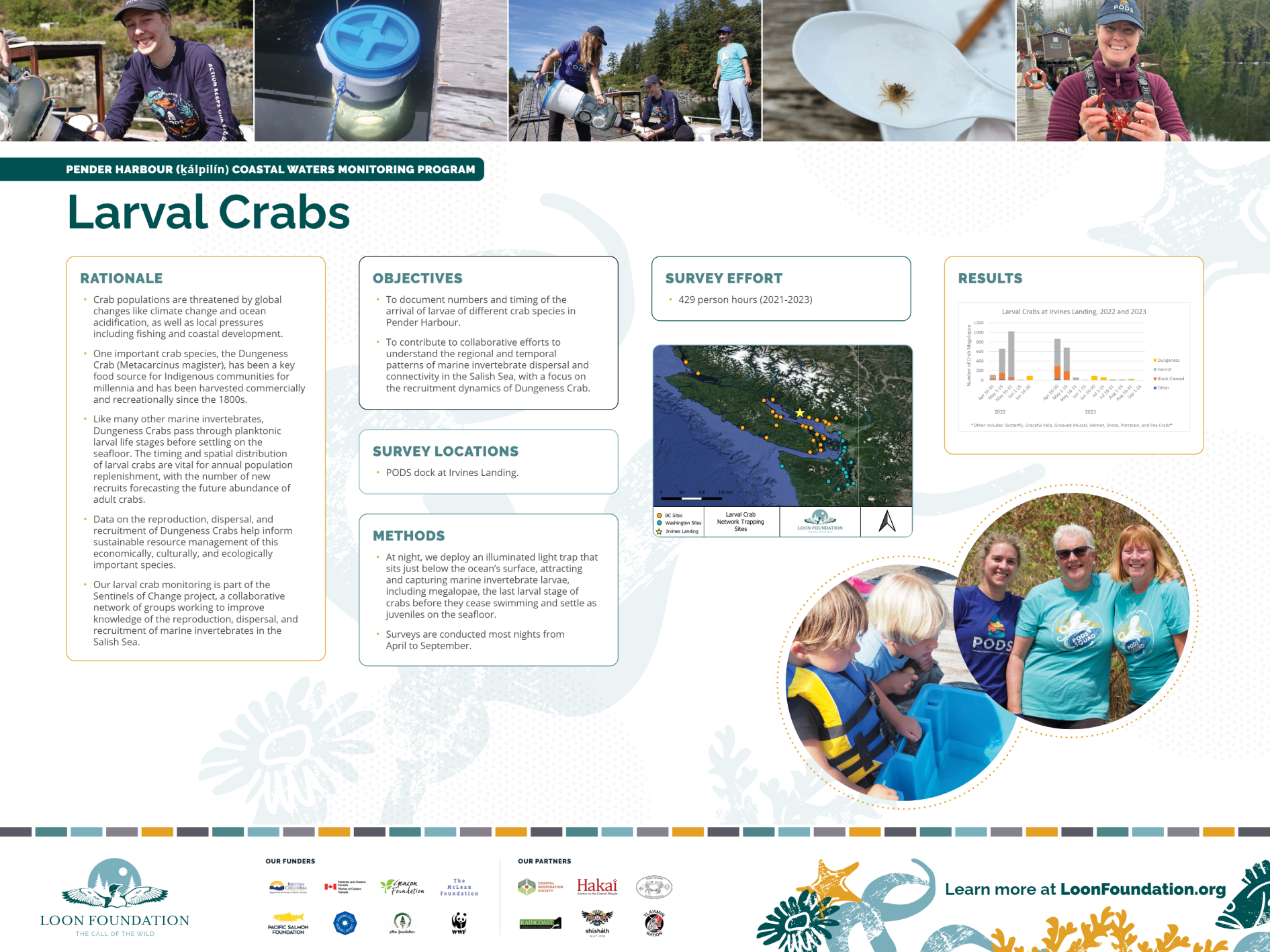
Pender Harbour Coastal Waters Monitoring Program
(PHCWMP)
The primary goal of the Pender Harbour Coastal Waters Monitoring Program (PHCWMP) is to develop long-term monitoring programs to assess changes in the aquatic ecosystems of the Pender Harbour region, so that we can make well-informed decisions about the management and protection of our valuable natural resources.
Through the PHCWMP the Loon Foundation intends to foster an energized local citizen science community of students, college graduates, researchers, volunteers, and retirees who are actively involved in monitoring the ecological health of our region, and who are committed to passing on the work to future generations.
We aim to partner with other organizations to create a network of collaborative monitoring programs throughout the Salish Sea.
What do we monitor?
-
Forage fish are small fish found in high numbers near the base of the food chain that consume plankton, linking the phytoplankton and zooplankton at the bottom of the food chain to whales, predatory fish, and sea birds at the top.
Long-term monitoring of forage fish spawning events allows us to quantify the changes in population, shifts in spawning habitat, and the effects that changing climate and habitat conditions have on these important fish.Our monitoring protocols were adopted from the BC Shore Spawners’ Alliance and updated to included protocols outlined by the World Wildlife Fund Canada and Washington State’s Fish and Wildlife Program.
-
Seagrass beds are vital marine habitats that provide essential breeding and nursery grounds for fish, reduce coastal erosion, improve water quality, store carbon, and form the base of productive marine food webs. These vital habitats are at risk from numerous impacts, including anchoring, dredging, pollution, runoff, and climate change.
Our Seagrass Monitoring Program enables us to document changes to these key ecosystems and identify opportunities for protection and restoration. Our survey protocols follow those outlined in Methods for Mapping and Monitoring Eelgrass Habitat in B.C.
-
The intertidal zone is one of Earth's most productive ecosystems, but it is also one of the most stressful, with organisms facing daily exposure to tidal changes, fluctuations in salinity and temperature, risks of desiccation, and other variables.
Long-term monitoring of intertidal organisms helps track changes in biodiversity, evaluate the impacts of environmental stressors, and inform conservation strategies to maintain ecosystem health and resilience.
-
Invasive species are usually characterized as having prolific reproduction and, in the absence of natural predators, rapid population growth leading to direct competition for habitat and food. This can lead to negative ecosystem impacts through disrupted food webs, as well as reproduction and habitat loss for native species. In addition to harmful effects on natural communities and ecosystems, invasive species can cause economic harm and human health impacts.
Monitoring for the arrival of invasive species helps ensure that management strategies can be implemented if required. To monitor for invasive species, we have started an underwater video log of key docks in the Pender Harbour Area. European green crab monitoring was established in 2019 as an expansion of the program. Following Washington State’s protocols, traps are set twice a month from April to October.
-
Pinnipeds are marine carnivorous mammals including seals, sea lions, and walruses. Along the coast of BC, pinnipeds play an important role influencing the dynamics and structure of marine ecosystems. As consumers of fish and invertebrates, they impact the growth, reproduction, and population size of prey species. Seals and sea lions also act as parasite hosts, transfer nutrients and energy in marine ecosystems, and influence habitat structure. As top predators, pinnipeds can also serve as indicators of environmental health and change.
Our pinniped surveys currently occur twice a year. Protocols are based on the Pinniped Long-Term Monitoring of the San Francisco Area Network of Parks, which provides an extensive framework for monitoring including parameters such as population size, distribution, reproductive success, and population ecology.
-
Pacific salmon are keystone species with immense ecological, cultural, and economic value. Long-term monitoring of the numbers of juvenile salmon in Pender Harbour creeks will help us to evaluate the impacts of anthropogenic stressors such as upland development, stream channelization, sport fishing, and climate change on our local salmon populations. Once there is more information about numbers in local spawning streams, work can be done to try and restore and maintain these vital populations.
Our priority area includes key streams in Pender Harbour’s Anderson Creek watershed. Survey methods include weekly salmon escapement counts between September and November following protocols and data templates provided by DFO.
-
Pacific salmon have ecological, cultural, and economic value; however, little collective information exists about juvenile salmon population sizes and migration. Juvenile salmon and other fish are sampled using a beach seine net at two established survey locations as well as various locations throughout Pender Harbour to determine which species are utilizing the area, and at what times.
Surveys are completed weekly from March to September. Data collected includes fish lengths and general health data such as number of lice (if any), as well as water quality parameters such as salinity. All data collected is reported to DFO.
-
Crab populations are threatened by global changes like climate change, ocean acidification, and local pressures like fishing and coastal development.
Our goal is to document numbers and timing of the arrival of larvae of different crab species in Pender Harbour, with particular focus on the Dungeness Crab. Monitoring will collect data as part of the Sentinels of Change Project, a collaborative network working to improve knowledge of the reproduction, dispersal, and recruitment of marine invertebrates in the Salish Sea.
-
Seabirds play many roles in marine ecosystems as predators, prey, scavengers, and dispersers of nutrients. Among the many threats that seabirds face are climate change, pollution, overfishing, introduced species, and human exploitation and disturbance. Changes in seabird populations are good indicators of long-term and large-scale change in marine ecosystems. Around the world, recent startling declines in seabird colonies have raised alarms.
Our monitoring program will identify which species are residing and migrating through the Pender Harbour region using monthly bird counts following protocols outlined at Bird Studies Canada. All data will be reported and made public through the Birds Canada website and through eBird.
-
Common loons are found within the coastal oceans during the winter and utilize the freshwater lakes in the spring and summer. Loons on the east coast have been experiencing decline due to pressures such as lead fishing tackle, climate change, shoreline development, predation, water fluctuations, and recreation.
Populations are monitored on the lakes to determine breeding success through nesting pairs and chick survival. We monitor lakes in Pender Harbour used by common loons following protocols outlined by Bird Studies Canada’s Loon Lake Monitoring Program.
Donations help support our ongoing scientific programs, including these monitoring programs!
2024 Monitoring Reports
See the results of our work!
2024 Forage Fish Findings
2024 Seagrass Findings
2024 Intertidal Macroinvertebrates and Seaweeds Findings
2024 Aquatic Invasive Species Findings
2024 Pinnipeds Findings
2024 Salmon Escapement Findings
2024 Juvenile Salmon Findings
2024 Larval Crabs Findings
2024 Coastal Waterbirds Findings
2024 Loons Findings











